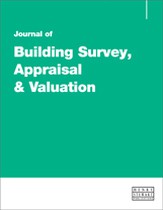Hygrothermal risk assessment of external wall insulation retrofit to non-traditional wall types in an Irish context, using the Glaser method and a heat, air and moisture transient model
Abstract
The Climate Action Plan 2019 targets the low-energy retrofit of 500,000 existing Irish homes before 2030.1 Up to 80 per cent of building failures can be attributed to moisture risks.2 The literature indicated that external wall insulation (EWI, ETICS) failures are mostly due to moisture ingress at junctions and interfaces. A hygrothermal risk assessment of EWI on three walls with rendered concrete/concrete blockwork/cavity walls in Dublin, Belfast and Belmullet was undertaken using transient numerical simulation and the Glaser method. The guidance, common practice indicates a preference for Glaser. The initial simulation results were compared to assess the appropriateness of Glaser. Material measurements were undertaken and this data was used in the transient numerical simulations. A parametric study was undertaken using a selection of the initial transient numerical simulations stressed with parameters of 1–2 per cent driving rain at different window positions. The results of the initial transient numerical simulations indicate that most retrofit cases, except on cavity walls, are low risk. All cases assessed using Glaser pass the assessments. The parametric study indicated between 40–67 per cent were high risk depending on the wall types. All cases with mineral wool/mineral render were low risk, while most cases with acrylic render were high risk. The research described in this paper indicates that using the Glaser method for hygrothermal assessment of EWI cannot capture the extent of the risk when buildings are leaking.
The full article is available to subscribers to the journal.
Author's Biography
Gareth Mc Donnell RIAI (Arch. Tech.), BSc (Hons) Arch. Tech., MSc, BP-EED is Senior Architectural Technologist – Building Performance Specialist for O’Shaughnessy & Associates Architects. Following his graduation from a Certificate in Construction Technology from D.I.T. Bolton Street in 2000, Gareth graduated from Leeds Metropolitan University in 2003 with First Class Honours in Architectural Technology. In 2016 Gareth became a registered Technologist with the RIAI with Environmental Accreditation. He has recently graduated from the Dublin School of Architecture, TU Dublin, with a level 9 MSc in Building Performance – Energy Efficiency in Design (BP-EED). The MSc qualification places Gareth at the forefront in the building performance sphere, providing robust evidence-based designs for new or deep retrofit nearly zero-energy building (NZEB) compliant and low carbon buildings. His area of research is hygrothermal risk evaluation and low-energy building design/retrofit. Gareth’s professional experience in architectural practice commenced in 1997 with Dunphy O’Connor Baird. He joined O’Shaughnessy & Associates Architects in 2000. Since then, he has completed projects in a wide range of sectors, including education, retail, healthcare, commercial, sports and leisure and residential. He has extensive experience working as the project lead with several international retail clients. He recently completed several commercial and residential retrofit/extension projects circa 100– 200m2 to BERs ranging from A2–B2 and is committed to designing robust low-energy low carbon buildings.
Joseph Little MRIAI, BArch NUI, Prof. Dipl. NUI, MSc Arch., AEES is Head of Construction and Building Performance in the School of Architecture, Building and Environment, TU Dublin. He holds an MSc in Architecture – Advanced Environmental and Energy Studies from the Graduate School of the Environment, Centre for Alternative Technology, Wales, and a Bachelor of Architecture and Professional Diploma (Architecture) from University College Dublin. He is a director and founder member of the Irish Green Building Council. Inter alia, Joseph is manager and programme chair of MSc in Building Performance (Energy Efficiency in Design) and BSc in Sustainable Timber Technology. His areas of research are hygrothermal risk evaluation, low carbon, circular construction, timber technology and energyefficient renovation. His passion is to support a fundamental shift towards a high-quality, lowimpact and sustainable built environment.
Citation
Mc Donnell, Gareth and Little, Joseph (2024, June 1). Hygrothermal risk assessment of external wall insulation retrofit to non-traditional wall types in an Irish context, using the Glaser method and a heat, air and moisture transient model. In the Journal of Building Survey, Appraisal & Valuation, Volume 13, Issue 1. https://doi.org/10.69554/UPWF3060.Publications LLP
